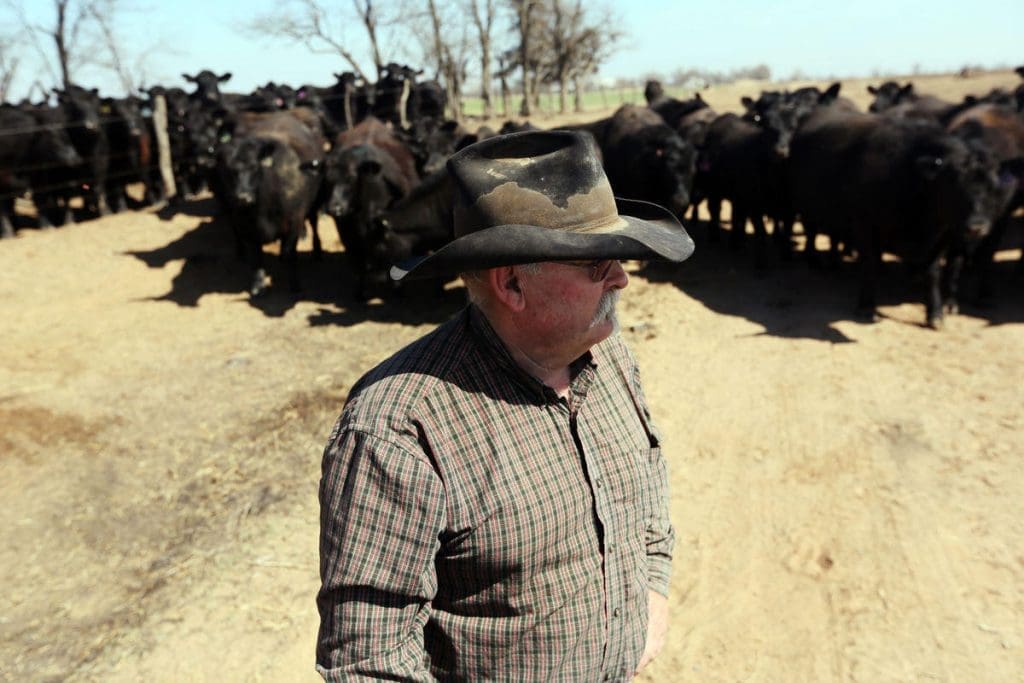
Greg Gardiner with Angus heifers salvaged from the recent fires on Gardiner Ranch in Kansas. Click on image for a larger view
LAST month, one of the world’s most influential Angus seedstock producers, Gardiner Angus Ranch in the US, lost 500 cattle and 6000 large round hay bales as wildfires razed 16,800ha of pasture on the Gardiner family’s Kansas landholdings.
Despite the immense challenges faced, the giant GAR operation, which has a strong influence in the Australia’s Angus seedstock population, still managed within weeks of the fire to conduct its 38th annual sale.
The 375 registered bulls sold averaged US$7100 (about A$9460) and 315 registered females averaged US$5325. Together with a run of 119 commercial females, the sale grossed US$4.65 million. The 245 successful buyers came from 32 US states and Mexico.
The 2000 cattle producers in attendance at the sale and online were told that GAR was ‘moving on’ after the fire, as a green tinge emerged in surrounding paddocks, the result of post-fire rains.
One of the stud principals, Mark Gardiner, who is well-known in Australian Angus breeding circles, lost his home in the fire.
He said the support from neighbors and those across rural America was “truly one of the most amazing stories of faith, friendship, and solidarity.”
GAR’s four generations of existence had never faced such a challenge he said.
What makes a seedstock operation like GAR tick, and survive and support four generations since 1898? The lessons may be useful for some fledgling seedstock producers, and even well-established operators in Australia.
While some seedstock operations are complex, GAR’s strategy is described as easy to understand and simple. Mark Gardiner puts the business’s success down to performance recording, enhanced by 100pc AI and ET breeding since 1964 to gain maximum genetic improvement, selection criteria and customer service.
Traditional selection tools meant genetic progress was slow until the introduction of the American Angus Association’s sire summary in 1980, he told a recent US cattle conference.
That was the start rapid advancement through serious sire selection based on economically important traits, he said.
Dad’s rule governed selection criteria
While rapid generation turnover is desirable, Henry Gardiner’s (Mark’s father) strategy was to only include ‘proven’ AI sires when charting matings.
“We call this discipline ‘dad’s rule’ and it has been the key to our success,” Mark said.
“Dads’ rule has been great, but it has caused us not to use some talented young sires including some of our own.”
Then along came genomics which has allowed GAR to keep to ‘Dad’s rule’, but still use younger and younger sires with EPDs enhanced by genomics.
“This has allowed us to use some of our young sires earlier than we could have in the past, without taking undue risk,” Mark said.
Genomic enhanced EPDs, powered by the HD50K Angus DNA test, equals 21 progeny calving weights, 11 birth weights, 16 marbling scores and nine ribeye measurements.
ET means stronger female influence
With 70pc of Gardiner Ranch’s bulls sold being the result of ET work, the stud’s bull marketing program begins with selection of bull mothers.
They start with around 900 yearling heifers assessed using pedigree information, performance data and EPDs (the equivalent of Australia’s EBVs) to reduce that group to 360, and then HD 50K genomics testing is used to enhance EPDs to come up with a final 70 elite donor females.
The ET program involved includes fresh, frozen and split embryos. In the period from 2006 to 2011, the 3033 fresh embryos implanted by Gardiner Ranch returned 62.5pc pregnancies; 1658 frozen embryos returned 58pc; while 645 split embryos were 54.7pc successful. But as Mark points out, that equates to a ‘109pc’ result, when multiplied by two.
While the cattle are obviously important, they are only ‘half of the equation’ in a successful seedstock business, he says.
The other half is customer service, with the real work before and after the sale.
Replacements and credits disclosed for all to see
While many seedstock operations in both Australia and the US offer breeding guarantees, how many would openly publish replacements and credits allowed each year, when things go wrong?
GAR guarantees all breeding cattle sold as fertile. If a bull is injured in the 12 months following the sale and becomes functionally infertile, the business will provide a satisfactory replacement or issue a credit for a future GAR sale.
If a female is determined to be a non-breeder, the difference between the purchase and salvage prices can be used as a credit at a future GAR sale.
The results of GAR’s breeding guarantee are transparent. They replace about 150 bulls a year, representing 7.5pc of bulls sold, and grant about $US250,000 (A$333,000) in credits.
“It’s some of the best money we ever spend,” Mark Gardiner said.
GAR’s Australian ‘disciple’ is Lawsons Angus founder. Don Lawson, who said Lawsons had used 100pc AI and ET matings for more than 20 years.
One staggering result, according to Don, is that since Lawson’s first sale in 1971, its sale bull weights had increased by 68pc, and today’s bulls are six months younger.
He also suggested that in the past 60 years, GAR had increased weaning weights by 72pc.
He describes the GAR – Lawsons alliance as “very productive, and very ethical.”
- Click here to access Beef Central’s upcoming bull sales list
- Click here to access Beef Central’s recently completed bull sales list
